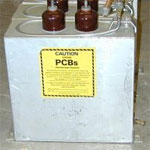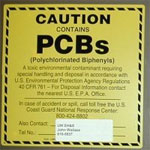Contact EPA Pacific Southwest Cleanup
Pacific Southwest, Region 9
Serving: Arizona, California, Hawaii, Nevada, Pacific Islands, Tribal Nations
PCBs Questions & Answers
On this page:
- What are Polychlorinated Biphenyls (PCBs)?
- What is a PCB Transformer?
- Do you own a PCB Transformer?
- How might I be exposed to PCBs?
- Can PCBs affect my health?
- What steps are being taken to address PCBs globally?
- Do PCBs pose a potential hazard on the ships anchored in Region 9?
What are Polychlorinated Biphenyls?
The manufacture of PCBs was stopped in the U.S. in 1977 because of evidence they build up in the environment and can cause harmful health effects.
Polychlorinated biphenyls (PCBs) are synthetic chemicals which are no longer produced in the United States, but are still found in the environment. PCBs have been used as coolants and lubricants in transformers, capacitors, and other electrical equipment because they don't burn easily and are good insulators. The manufacture of PCBs was stopped in the U.S. in 1977 because of evidence they build up in the environment and can cause harmful health effects. Products made before 1977 that may contain PCBs include old fluorescent lighting fixtures and electrical devices containing PCB capacitors and hydraulic oils.

What is a PCB transformer?
Polychlorinated biphenyls (PCBs) were used in electrical transformers manufactured between 1929 and 1977, with the majority being installed in residential and commercial buildings and industrial facilities prior to 1978. A “PCB transformer” is a transformer that is known, or assumed under TSCA, to contain PCBs at concentrations greater than 500 parts per million (ppm). “PCB-Contaminated Transformers” known, or assumed under TSCA, to contain between 50 and 499 ppm PCBs are also subject to EPA regulations.
Do you own a PCB Transformer?
Generally, a transformer will have a nameplate attached to the unit indicating the name of the dielectric fluid, the approximate weight in pounds, and the amount of fluid, usually in gallons. In accordance with the Toxic Substance Control Act (40 C.F.R. § 761.40 (a)), proper PCB identification labels must be visible near the access to the transformers and also on the transformer itself.
Since PCBs were marketed under different names, the nameplate on a PCB Transformer may not carry the specific term "PCBs". Trade names for PCBs could include:
- Abestol, Aroclor, Askarel, Chlophen
- Chlorextol, DK, EEC-18, Fenclor
- Inerteen, Kennechlor, No-Flamol, Phenoclor
- Pyralene, Pyranol, Saf-T-Kuhl, Solvol
- Non-Flammable Liquid
If the nameplate says "PCBs" or any of the names on the above list, then the transformer most likely contains PCBs. If the transformer's nameplate does not have any of the above labels, or if the label is missing or illegible, the utility company may be able to tell if the transformer contains PCBs. Otherwise the only way to be certain is to test the electrical fluid.
How might I be exposed to PCBs?
Fluorescent lighting fixtures, electrical devices and appliances manufactured 30 or more years ago may leak small amounts of PCBs and be sources of skin exposure. During normal operation of this equipment, the PCBs are entirely enclosed. When the equipment wears out, however, it can burn or break and leak PCBs. Although exposure no longer occurs as a result of the manufacture of PCB-containing products, it can still occur during the maintenance or repair of equipment that contains PCBs or as a result of accidents involving such equipment.
Though not a significant concern in Region 9, consuming contaminated food could be an additional source of exposure. The main dietary sources of PCBs are fish (especially sportfish caught in contaminated lakes or rivers), meat, and dairy products. The California Office of Health Hazard Assessment provides FAQs about PCBs in sports fish (PDF) (3 pp, 25K). ![]()
PCBs and Public Health Resources
The Agency for Toxic Substances and Disease Registry (ATSDR)
- The ATSDR toxicological profile for PCBs
 characterizes the toxicity and adverse health effect information for PCBs.
characterizes the toxicity and adverse health effect information for PCBs. -
ATSDR public health statement for PCBs

-
ATSDR has also released "Public Health Implications of Exposure to PCBs,"
 documenting health consequences of PCB exposure.
documenting health consequences of PCB exposure.
Can PCBs affect my health?
PCBs have been shown to cause a variety of adverse health effects and are associated with acne-like skin conditions in adults and neurobehavioral and immunological changes in children. The EPA has also classified all PCBs as probable human carcinogens.
Workers exposed to high levels of PCBs on the job have documented skin and eye irritation. To protect workers against the health effects of exposure to hazardous substances (including PCBs), the Occupational Health and Safety Administration (OSHA) sets permissible exposure limits (PELs). PELs are regulatory limits on the amount or concentration of a substance in the air
What steps are being taken to address PCBs globally?
The Stockholm Convention ![]() is a global treaty to protect human health and the environment from Persistent Organic Pollutants (POPs), including PCBs. POPs are chemicals that remain intact in the environment for long periods, become widely distributed geographically, accumulate in the fatty tissue of living organisms and are toxic to humans and wildlife.
is a global treaty to protect human health and the environment from Persistent Organic Pollutants (POPs), including PCBs. POPs are chemicals that remain intact in the environment for long periods, become widely distributed geographically, accumulate in the fatty tissue of living organisms and are toxic to humans and wildlife.
Do PCBs pose a potential hazard on the former Naval ships anchored in Region 9?
PCBs & Ships
Additional Resources
- A Guide for Ship Scrappers: Tips for Regulatory Compliance (PDF) (261 pp, 1.2MB)
- Best Management Practices for Preparing Vessels Intended to Create Artificial Reefs (PDF) (77 pp, 1.8MB)
- The United Nations Environment Programme (UNEP) news article on the consequences of ship dismantling: "Ship Dismantling Industry Set to go Green."

Out-of-service ships within Region 9 can contain PCBs and PCB-contaminated material. For vessels deployed before the 1979 PCB ban, PCBs may be found in both the solid (waxy) and liquid (oily) forms in equipment and materials onboard ships. The equipment that may contain PCBs in concentrations of greater than or equal to 50 ppm include: cable insulation, rubber and felt gaskets, electronic equipment, caulking, oil-based paint etc.
Some of these ships are considered for dismantling or use as artificial reefs. Ships containing PCBs and PCB contaminated materials, however, require regulatory guidance and cleanup before dismantling or use as an artificial reef.


